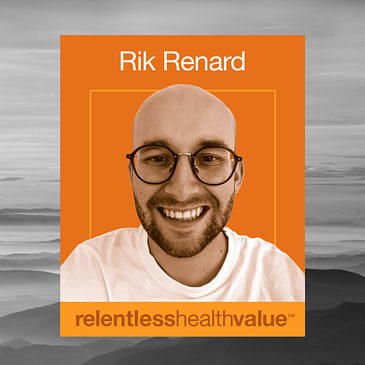For a full transcript of this episode, click here.
Hey, Relentless Health Value Tribe, thanks so much for being here this week. I gotta say, I really appreciate all of you who write and tell me that you kick off your Thursdays by listening to this show every week.
You just pop open your app and you listen to the show. Because yeah, we’re a pretty sure thing over here. If the guest was boring or if the guest was talking about stuff that I already know and probably you already know, the guest would not be on the show. So, listening to Relentless Health Value every week is a hugely easy way to just keep up with what’s going on and, at the same time, get a pretty holistic deep dive into how all of the various parts of the industry fit together and how they ultimately impact patients and anybody who is at risk to pay for their care.
One thing that you’ll notice about the guests who we invite to come on Relentless Health Value, they are usually not the ones who are merely going to recite a very well-curated point of view that is fully in line with some marketing pitch. It would be easy enough, honestly—it would be so much easier—to just invite all of the bigwigs who we get pitched.
I get 50 pitches a day from PR teams who want to get their executives to come on the show because they want to get their message out to you, Relentless Health Value Tribe. You, for sure, have a reputation of being industry movers and shakers. Although it would be super easy for me to phone it in and let them have their way with you, I’ve never been one to take the easy way.
I want to find those individuals to be guests who are willing to share actionable insights to actually tell the truth. I’m really not into someone hijacking this platform for their own self-interest when that self-interest is not aligned with anything that I would consider a win-win for patients.
You’ll probably find more actionable insights here than listening to talk tracks, even if you’re just listening to figure out what to include in your pitch to some of these industry insiders. I’m gonna tell you that repeating their marketing spin or their party line isn’t probably gonna sell much. What they will say in public and what they really want to do are so very often sadly at counterpoint. So, come here for the real story.
Alright, so let’s get to the conversation that we’re gonna have today, which is about and for digital health vendors’ or virtual care providers’ point solutions (they go by many names) and also for anybody who is a customer of said solutions.
If we’re taking it from the top here, let me just make a Captain Obvious point. These digital health vendors, they kind of have to perform better than the traditional community health providers. Otherwise, they have no reason to exist, really, right? Purchasers would just go with the local gang of care providers. So then, what does “perform better” actually mean? Let’s discuss.
I’d say perform better means to offer better measurable patient outcomes probably, both clinically and patient reported. I’d also say it means to offer more affordability. Also, better engagement, accessibility, and maybe all of this at a better cost profile for purchasers such as employers or health plans that are taking on actual risk.
So, if all things are equal, again, why the heck would an employer or other purchaser even bother? It couldn’t even be considered, honestly, a member benefit from a regular benefit perspective if the local standard of care is superior or just as good.
Now, if any clinical entity is looking to actually achieve better performance in any or all of the ways that I just mentioned with any level of consistency and in a way that is profitable for them and their investors, you got to do a few things. And one of them is to design and implement care flows, care processes, pathways—again, you can pick a name and define it how you like. But bottom line, there needs to be a standardized way to deliver high-quality care that is measurable.
Here’s Ali Khan, MD, MPP, who is chief medical officer over at Oak Street Health, talking about this. He says:
“At Oak Street Health we think about standardization as a 70/30 split. It is important that the largest aspects of what your care team does are standardized. (...) The bulk of the work that we do is to make sure not only that we set standards, but that we also disseminate standards, coach standards, review standards, and then update and iterate those based on the things we learned. Our standards are constantly evolving and improving.”
Okay, so said another way, gotta have and use care flows. This doesn’t seem like rocket science, but yeah, that is a blue’s clue for what’s coming up here.
So, how are most digital health vendors doing when it comes to care flows performing better? Rik Renard and Thomas Vande Casteele from Awell have done a survey with a group called Health Tech Nerds and have dug into the usage of care flows among, specifically, digital health vendors.
Given everything aforementioned, I wasn’t surprised to hear that 84% of digital health vendors use care flows in 2023 … 84%. But it was kind of shocking, to be honest, to hear that in 2023, only 16% use care flows that they feel are based on evidence and the science of medicine.
If you don’t follow the latest science, then outcomes, both clinically as well as probably patient-reported outcomes, won’t be of the “perform better” variety.
Oh, boy. Also, only 7% of respondents have the ingredients to build a 360-degree picture of how their flows impact finances and quality of care. And I say that because only 7% can and do measure four things. And here’s the four things:
1. Performance metrics such as patient engagement and compliance rates
2. Financial metrics such as revenue per patient/per member
3. Clinician-reported outcomes
4. Patient-reported outcomes, or PROMs
Seven percent. That is less than one out of ten of these digital health vendors. There are other higher, but still pretty sad, percentages that measure combinations of the above four factors; but only 7% measure all of them.
And if you don’t or can’t measure what you’re doing, then you wind up with what my guest Rik Renard calls black box care, which is another way of saying if you don’t measure it, you can’t manage it. Because think about it, if you have black box care, well, the solutions to perform better are also a black box. If you don’t know the problem, good luck finding the solution to it.
A few things as we contemplate all of this. First of all, as Stacy Mays pointed out to me, if that digital health vendor is working for different payers or different purchasers, those different payers or purchasers might demand different care flows; and those different care flows might ladder up to different ultimate goals.
The hard part about being a digital health vendor employed by a payer or a purchaser is that your customer is the boss of you. So, complication. The other relevant conversation I had is with David Claud, MD, PhD, who told me that many employers/customers evaluating healthcare vendors, like on-site clinics, do not have the clinical expertise to meaningfully evaluate the quality of care; so, they tend to focus more on cost and service. When this happens, you kinda wind up with a race to the bottom, where being really nice and being cheap are more important than actually delivering high-quality care that no one can measure anyway.
And the last point that I’ll bring up is what Sanat Dixit, MD, MBA, FACS, brought up the other day; and I love how he put it. He said doctors don’t tend to caucus well. And coming up with care standards and best practice care flows means getting everybody to walk the same pathways. Bottom line, it’s really pretty hard to be a digital health entrepreneur these days.
Coming up here, I have a conversation with Barbara Wachsman. Barbara was the managing director over at Disney. She’s worked for PE (private equity) as well as being executive director over at PBGH, the Purchaser Business Group on Health. So, that’s upcoming in a couple of weeks. But the point that Barbara makes, which I think is really apropos here, she said that, in the United States, we desperately need really talented and great digital health vendors, great entrepreneurs, ones who actually can deliver real results and do it at a fair price.
So, my hope is that we get better at these care flows. Now, I say all this to say, let’s take the conversation today as an opportunity for both entrepreneurs, vendors, as well as customers like employers and other purchasers or payers. It’s an opportunity to recognize and work together where there’s room for improvement and also place value on achieving that headroom.
As I mentioned earlier, in this healthcare podcast I am speaking with Rik Renard from Awell. Rik has a background in nursing and healthcare management. He joined Awell four years ago and now manages strategic accounts.
For more on this topic, listen to the show with George Mathew, MD, MBA, FACP (EP253).
Also mentioned in this episode are Ali Khan, MD, MPP; Oak Street Health; Thomas Vande Casteele; Stacy Mays; David Claud, MD, PhD; Sanat Dixit, MD, MBA, FACS; Barbara Wachsman; George T. Mathew, MD, MBA, FACP; Yubin Park, PhD; Jessica H. Green, MPH; Thyme Care; Better Health; Wellinks; Bob Matthews; Emily Kagan Trenchard; Robert Pearl, MD; and J. Michael Connors, MD.
You can learn more at Awell and CareOps.
You can also follow Rik on LinkedIn and X (formerly Twitter).

As the coauthor and driving force behind CareOps, a vibrant community of over 4000 healthcare professionals focused on enhancing care flows, he imparts insights on designing and improving care flows. His expertise is grounded in over five years of hands-on experience, during which he has successfully implemented over 50 care flows in various medical areas, including oncology, musculoskeletal disorders, and cardiovascular care. These efforts have significantly improved patient outcomes and efficiently freed up time for healthcare teams.
Holding a master’s degree in health care management and policy from Ghent University, Rik combines his educational background with real-world experience to make a tangible impact in healthcare.
09:26 Why should clinicians care about care processes and care flows?
12:05 Why do care flows and care processes have a bad reputation?
12:31 What components does a good pathway include?
14:51 Why pathways need to be looked at as a process of continuous reconfiguration.
17:15 Who did Awell survey about care processes and flows?
18:42 How many clinicians were using care flows, and what did those care flows look like?
25:45 EP315 with Bob Matthews.
26:44 EP392 with Emily Kagan Trenchard.
28:21 EP412 with Robert Pearl, MD.
30:01 “Just document something.”
30:14 What was a shocking find from this care process survey?
31:06 Is AI the answer?
34:13 Why is it important to get the foundation of data correct before introducing AI?
34:51 How should employers use this information to vet vendors?
You can learn more at Awell and CareOps.
You can also follow Rik on LinkedIn and X (formerly Twitter).
@rikrenard discusses #digitalhealthvendors and #patientoutcomes on our #healthcarepodcast. #healthcare #podcast #digitalhealth #healthcareleadership #healthcaretransformation #healthcareinnovation
Recent past interviews:
Click a guest’s name for their latest RHV episode!
AJ Loiacono (Encore! EP379), Nina Lathia, Marshall Allen, Stacey Richter (INBW39), Peter Hayes, Joey Dizenhouse, Benjamin Jolley, Emily Kagan Trenchard (Encore! EP392), Cora Opsahl (Encore! EP372), Jodilyn Owen

